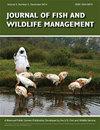内布拉斯加州一个大型水库中白眼鱼性别比例的季节和空间分布
IF 0.9
4区 环境科学与生态学
Q4 BIODIVERSITY CONSERVATION
引用次数: 0
摘要
在大型水库的空间尺度和非产卵期,尽管在此期间进行了标准化采样,但雌性与雄性的比例却很少受到关注。本研究评估了在一个大型水库内不同空间区域的季节性采样中,雌性白眼鱼的比例是否在0.450-0.550之间,这与1:1的雌雄比例密切相关。我们使用具有二项似然的贝叶斯广义线性混合效应模型,以季节(春季和秋季)和库区(河流、过渡带和湖泊)为固定效应,年份(2015年和2016年)为随机效应来评估白眼鱼的比例。我们使用标准化的内布拉斯加州狩猎和公园委员会(Nebraska Game and Parks Commission)的gill - net方法共收集了2163条瓦利眼鱼,并在每个水库区收集了随机的鱼子样本(n = 989)来确定性别。春季和秋季在河流和过渡带捕获的雌眼鱼比例的平均后验估计值在0.450-0.550范围内无显著偏差。春季湖盆带雌眼鱼比例的后验均值(SD)为0.182(0.024),秋季为0.621(0.032)。这些结果与之前观察到的春季产卵地点附近雄性增加的现象一致,并表明湖区秋季雌性捕捞量的增加可能会影响采样结果。这项研究进一步深入了解了大平原水库的性别分布,并证明了在标准化的秋季调查中需要对瓦利耶鱼进行性别区分。本文章由计算机程序翻译,如有差异,请以英文原文为准。
Seasonal and Spatial Distribution of Walleye Sex Ratios in a Large Nebraska Reservoir
The ratio of female to male Walleye Sander vitreus across the spatial scale of large reservoirs and during non-spawning times receives little attention, even though standardized sampling occurs during this time. This study evaluated whether the proportion of female Walleye collected from seasonal sampling at different spatial areas within a large reservoir fell within the 0.450-0.550 range, which would closely reflect a 1:1 female-to-male sex ratio. We used a Bayesian generalized linear mixed effects model with a binomial likelihood to assess the proportion of Walleye using season (spring and fall) and reservoir zone (riverine, transitional, and lacustrine) as fixed effects and year (2015 and 2016) as random effects. We collected a total of 2,163 Walleye using standardized Nebraska Game and Parks Commission gill netting methodology, and sex was determined on a random subsample of fish (n = 989) collected throughout each reservoir zone. There was no meaningful deviation from the 0.450-0.550 range in the mean posterior estimate of the proportion of female Walleye caught in the riverine and transitional zones during either spring or fall. The mean (SD) posterior estimate of the proportion of female Walleye in the lacustrine zone was 0.182 (0.024) in the spring and 0.621 (0.032) in the fall. These results are consistent with previous observations of increased male presence near spawning locations in the spring and demonstrate that increased fall female catch in the lacustrine zone could potentially bias sampling results. This study provides further insight into the distribution of sexes across the spatial gradient of a large Great Plains reservoir and demonstrates a need to sex Walleye during standardized fall surveys.
求助全文
通过发布文献求助,成功后即可免费获取论文全文。
去求助
来源期刊

Journal of Fish and Wildlife Management
BIODIVERSITY CONSERVATION-ECOLOGY
CiteScore
1.60
自引率
0.00%
发文量
43
审稿时长
>12 weeks
期刊介绍:
Journal of Fish and Wildlife Management encourages submission of original, high quality, English-language scientific papers on the practical application and integration of science to conservation and management of native North American fish, wildlife, plants and their habitats in the following categories: Articles, Notes, Surveys and Issues and Perspectives. Papers that do not relate directly to native North American fish, wildlife plants or their habitats may be considered if they highlight species that are closely related to, or conservation issues that are germane to, those in North America.
 求助内容:
求助内容: 应助结果提醒方式:
应助结果提醒方式:


